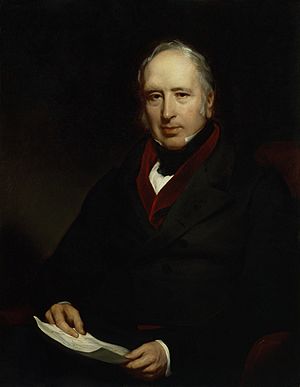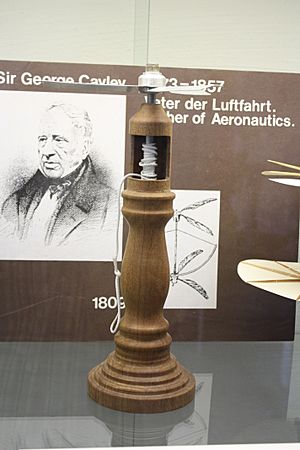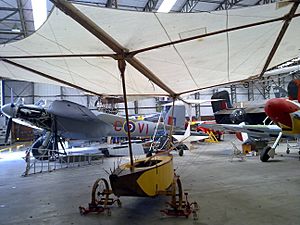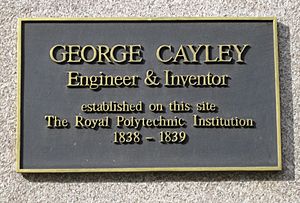George Cayley facts for kids
Quick facts for kids
Sir George Cayley
|
|
|---|---|

Portrait of Cayley c.1840 by Henry Perronet Briggs
|
|
| Born | 27 December 1773 |
| Died | 15 December 1857 (aged 83) Brompton, Yorkshire, England
|
| Nationality | English |
| Citizenship | British |
| Known for | Designed first successful human glider. Discovered the four aerodynamic forces of flight: weight, lift, drag, thrust; and cambered wings, basis for the design of the modern aeroplane. |
| Spouse(s) | Sarah Benskin Charlotte Elizabeth Illingworth |
| Scientific career | |
| Fields | Aviation, aerodynamics, aeronautics, aeronautical engineering |
Sir George Cayley (born December 27, 1773 – died December 15, 1857) was an English engineer, inventor, and a pioneer in aviation. He is considered one of the most important people in the history of flight. Many call him the first true scientific investigator of air travel.
Cayley was the first to understand the basic rules and forces of flight. He also created the wire wheel, which is still used today. In 1799, he came up with the idea of the modern airplane. He imagined it as a fixed-wing machine with separate parts for lift, power, and control.
He is often called "the father of aviation." Cayley identified the four main forces that act on a flying machine: weight, lift, drag, and thrust. Modern airplane design is based on these discoveries. He also showed the importance of curved wings, which he also suggested.
Cayley built the first flying model airplane. He also drew diagrams of how vertical flight could work. He designed the first glider that was known to carry a human. He correctly predicted that people wouldn't fly for long until a light engine was invented. The Wright brothers, who made the first successful airplane, recognized his important work.
Cayley was also a Member of Parliament for Scarborough from 1832 to 1835. In 1838, he helped start the UK's first Polytechnic Institute. This school is now the University of Westminster. He was also a founding member of the British Science Association.
Contents
Cayley's Engineering Inventions
George Cayley inherited large estates in Yorkshire. He was very optimistic about new ideas and worked on many different engineering projects. He developed many useful things.
Some of his inventions include self-righting lifeboats. These boats could turn themselves upright if they capsized. He also invented tension-spoke wheels. These wheels are lighter and stronger than older designs.
Cayley also worked on a "Universal Railway," which was his name for caterpillar tractors. These machines could move over rough ground. He designed automatic signals for railway crossings. He also invented seat belts for safety.
He created small helicopters and an early internal combustion engine. This engine was powered by gunpowder. He thought that a better engine could use gas instead of gunpowder. This idea led to the modern internal combustion engine.
Cayley also helped with artificial limbs and air engines. He studied electricity, theatre architecture, and ballistics (the study of how things fly). He also worked on optics (the study of light) and land reclamation. He believed that all these new ideas should be shared freely.
In 1807, Cayley invented the first working hot air engine. Later, in 1837, he designed a hot air engine that used burning gases directly on a piston. This was an early step towards the internal combustion engine.
Pioneering Flying Machines
Cayley is best known for his groundbreaking work on flying machines. This includes the working, piloted glider he designed and built. He wrote an important three-part series called "On Aerial Navigation." This was published between 1809 and 1810.
Sketches found in Cayley's school notebooks show his early ideas about flight. These drawings suggest he understood the idea of a lift-generating inclined plane as early as 1792. To measure how much air resistance objects had, he built a "whirling-arm apparatus." He also experimented with different wing shapes in the stairwells of his home.
These scientific tests helped him develop an efficient curved airfoil. He also identified the four forces that affect an aircraft: thrust, lift, drag, and weight. He discovered that the dihedral angle helps with side-to-side stability in flight. He also placed the center of gravity of his models below the wings for stability. These ideas influenced the design of hang gliders.
Because of his many studies, many people now see him as the first aeronautical engineer. His focus on making things light led him to invent a new way to build lightweight wheels. These wheels are still used today. He made the spokes from tightly-stretched string instead of solid material. This changed the forces on the spokes from pushing to pulling. Wire soon replaced string, and wire wheels became common on bicycles, cars, and airplanes.
The model glider Cayley successfully flew in 1804 looked like a modern aircraft. It had a kite-shaped wing at the front. It also had an adjustable tail at the back with horizontal and vertical fins. A movable weight allowed him to adjust the model's center of gravity.
Around 1843, he was the first to suggest the idea of a convertiplane. This is an aircraft that can take off and land like a helicopter but fly like a plane. Before 1849, he designed and built a biplane that a ten-year-old boy flew. Later, with help from his grandson George John Cayley, he developed a larger glider. This glider flew across Brompton Dale in 1853.
The first adult to fly this glider might have been Cayley's coachman, footman, or butler. Some sources suggest it was an employee named John Appleby. However, there is no clear proof of who the pilot was. An entry in the 1855 Encyclopædia Britannica is the most reliable record of the event. A 2007 book about Cayley claims his grandson, George John Cayley, was the first pilot.
A copy of the 1853 machine was flown in 1973 for TV. It was also flown in the 1980s for an IMAX film. This replica is now on display at the Yorkshire Air Museum. Another replica was flown in Kansas in 2003. Richard Branson also piloted it in Brompton in 2003.
Remembering Sir George Cayley
Sir George Cayley passed away in 1857. He was buried in the churchyard of All Saints' Church in Brompton-by-Sawdon.
His work is remembered in several places. At the University of Hull, Scarborough Campus, a student residence hall and a teaching building are named after him. Loughborough University also has a hall of residence and a bar named in his honor. The University of Westminster has a gold plaque at its Regent Street building. This plaque honors Cayley's role in starting the institution.
The Royal Air Force Museum London has displays and a film about Cayley's achievements. The Yorkshire Air Museum also has an exhibition and film called "Pioneers of Aviation." The Sir George Cayley Sailwing Club, a free flight club in North Yorkshire, has been named after him since 1975.
In 1974, Cayley was recognized for his contributions. He was inducted into the International Air & Space Hall of Fame.
Family Life
On July 3, 1795, George Cayley married Sarah Walker. She was the daughter of his first teacher, George Walker. They had ten children together, but three of them died when they were young. Sarah passed away on December 8, 1854.
See also
 In Spanish: George Cayley para niños
In Spanish: George Cayley para niños
- Early flying machines
- Matthew Piers Watt Boulton
- William Samuel Henson
- Timeline of aviation – 18th century
- Timeline of aviation – 19th century
- Kite types





